Both Sarina Wiegman’s England team and Lars Søndergaard’s Denmark went into their second game in Group D, knowing that a victory would give them the best possible chance to secure their place in the first knockout round.
In the opening group game, the Danes left it late to seal a 1-0 victory against China, whilst the Lionesses put in a rather lacklustre performance and had to rely on a retaken penalty by Georgia Stanway to see off Haiti. Safe to say both teams were looking to put in better performances on matchday two.
This performance did little to dispel the doubts raised about England’s performance in the opening game. Wiegman’s team got off to the perfect start and took the lead within six minutes, thanks to Lauren James. For 20 minutes after that, the Lionesses resembled the aggressive and dynamic team we saw in the Euros. However, Denmark slowly built into the game and can consider themselves unlucky not to come away with at least one point.
This tactical analysis will look at the tactics used by England, which saw them grind out another 1-0 victory despite having to withstand some heavy Denmark pressure throughout the game. This analysis will also look at how England will have to adapt due to the injury sustained by Keira Walsh, who went off injured in the first half.
Lineups
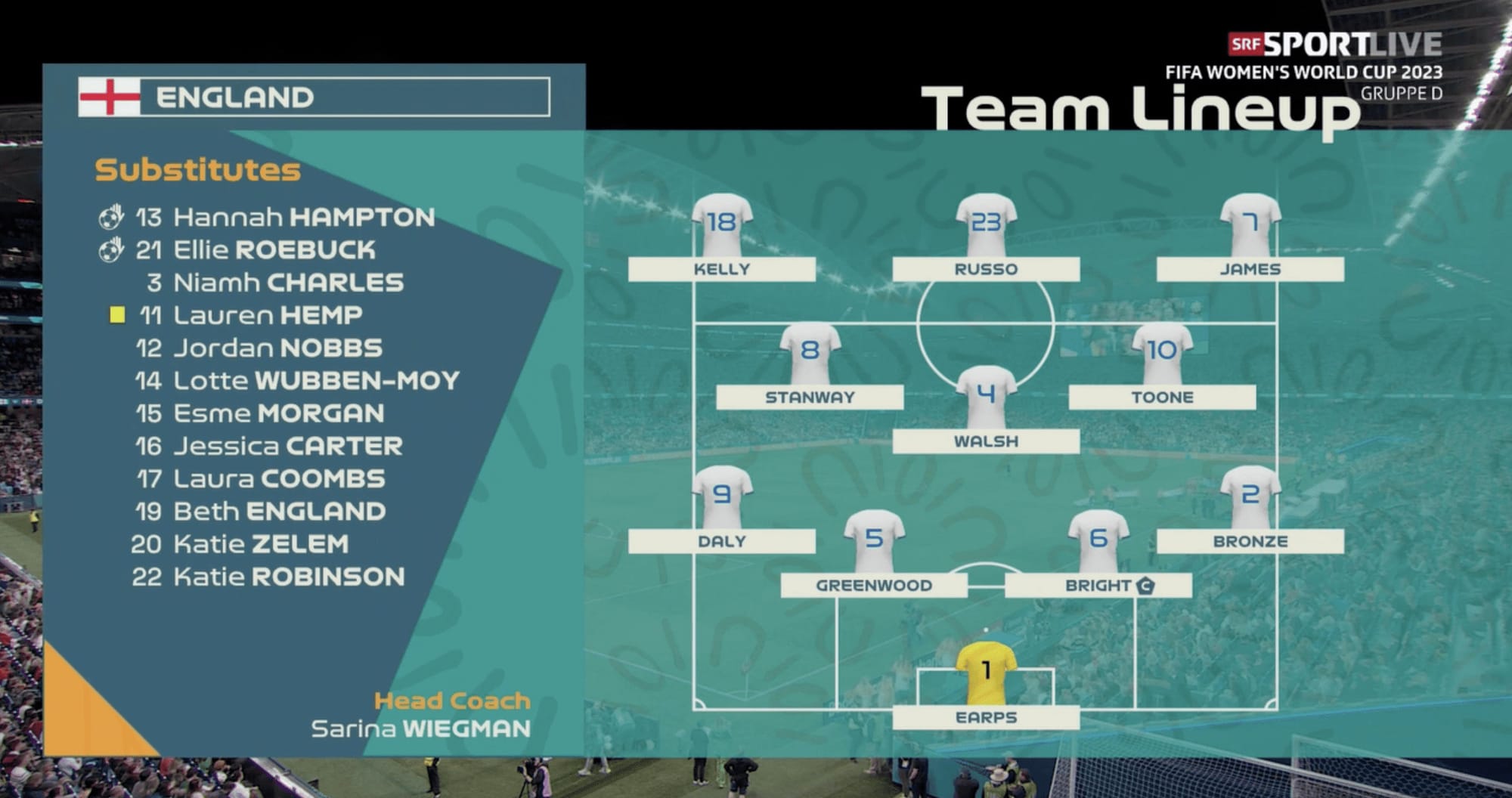
England lined up in their usual 4-3-3 formation. However, Sarina Wiegman did opt to make some changes from the team that played against Haiti; Alex Greenwood came in to play as a centre-back in this game, meaning Jess Carter dropped to the bench. Therefore WSL top scorer Rachel Daly came in to play at left-back, as we saw in Euro 2022. Additionally, Chelsea‘s Lauren James got the nod ahead of Lauren Hemp in the starting eleven, and please note that this was a direct swap, and James lined up on the left despite what the graphic shows.
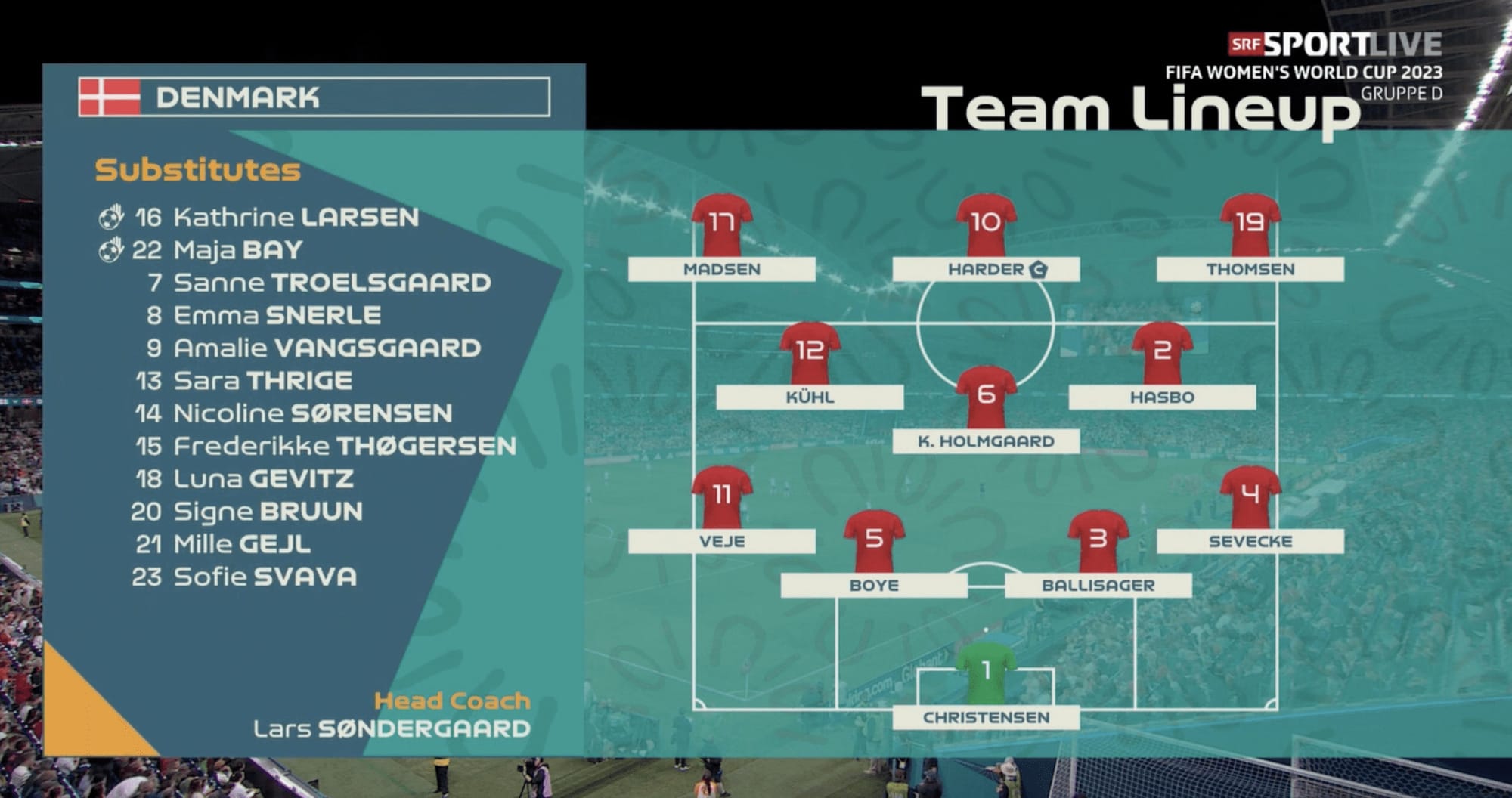
Denmark also lined up in a 4-3-3 formation with Christensen in goal, a vastly experienced back four of Rikke Sevecke, Stine Ballisager, Simone Boye and Katrine Veje. The midfield consisted of Holmgaard as the pivot player, with Hasbo and Kühl given more licence to attack. The front three consisted of Janni Thomsen, Rikke Madsen, and Bayern Munich‘s Pernille Harder leading the line, but she was also given the freedom to drop in and play as a 10.
England’s strong start
The Lionesses demonstrated their attacking intent right from the off. They were much more aggressive in attack and on the front foot compared with what we saw in the game against Haiti.
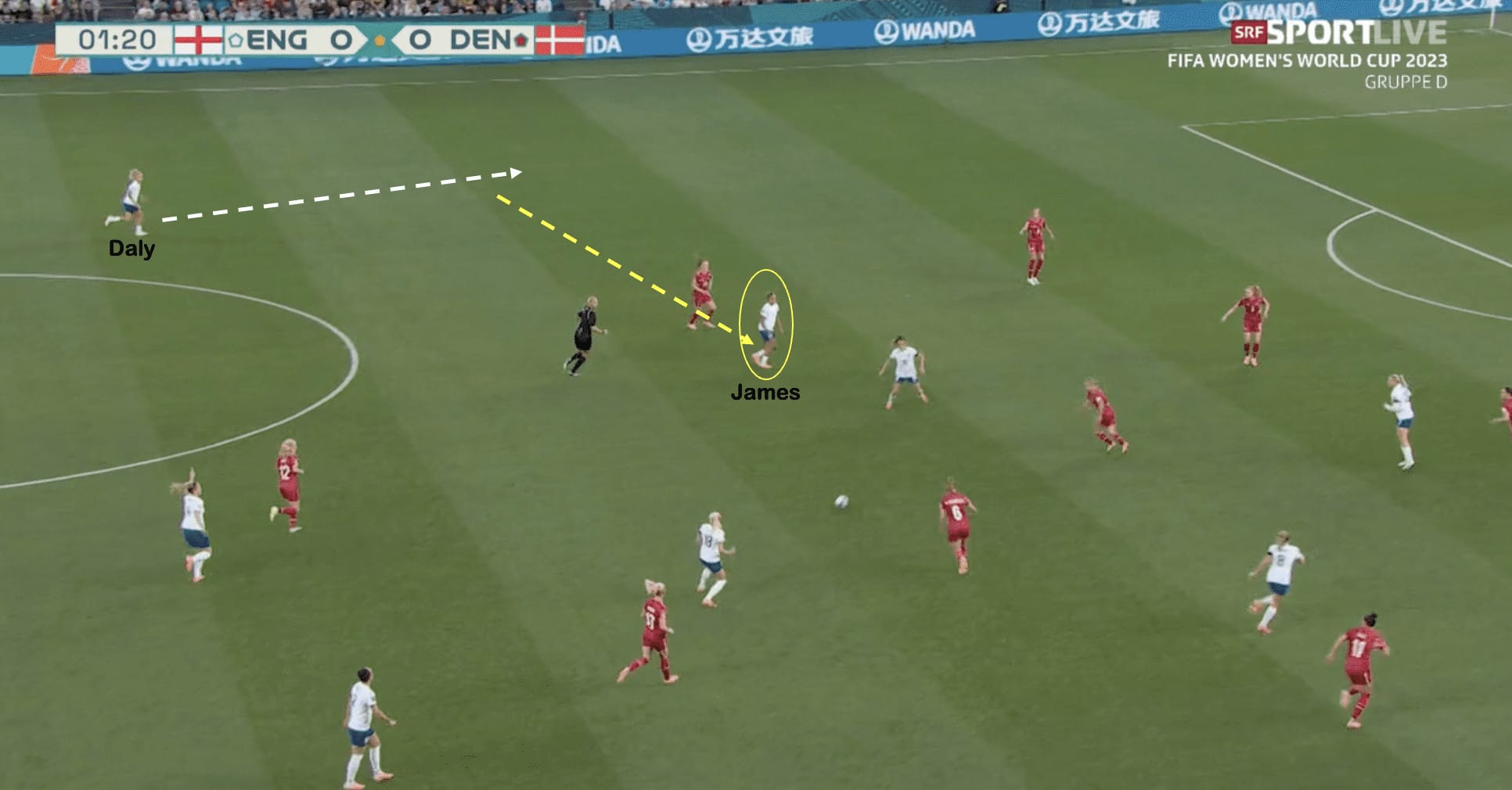
Lauren James’ inclusion in the starting eleven presented England with another element to their attacking play. This was evident from the first minute. As we can see in the image above, James’ natural instinct is to move into more central areas.
By moving centrally, James could create numerical advantages for England in the central areas of the pitch. This allowed the Lionesses to retain the ball much better and provided increased passing options. Lauren Hemp is a natural left-footer and would perhaps look to stay wider, which would keep the Danish defenders wider, whereas James’ movement infield allowed England to play short, sharp passes in tight spaces and created space down the left wing.
As we can see above, the Danish defenders and midfielders have moved narrower to close down England’s players and cut off their passing lanes. This meant that Rachel Daly often had a vast amount of space ahead of her and could consistently make overlapping runs down the left wing.
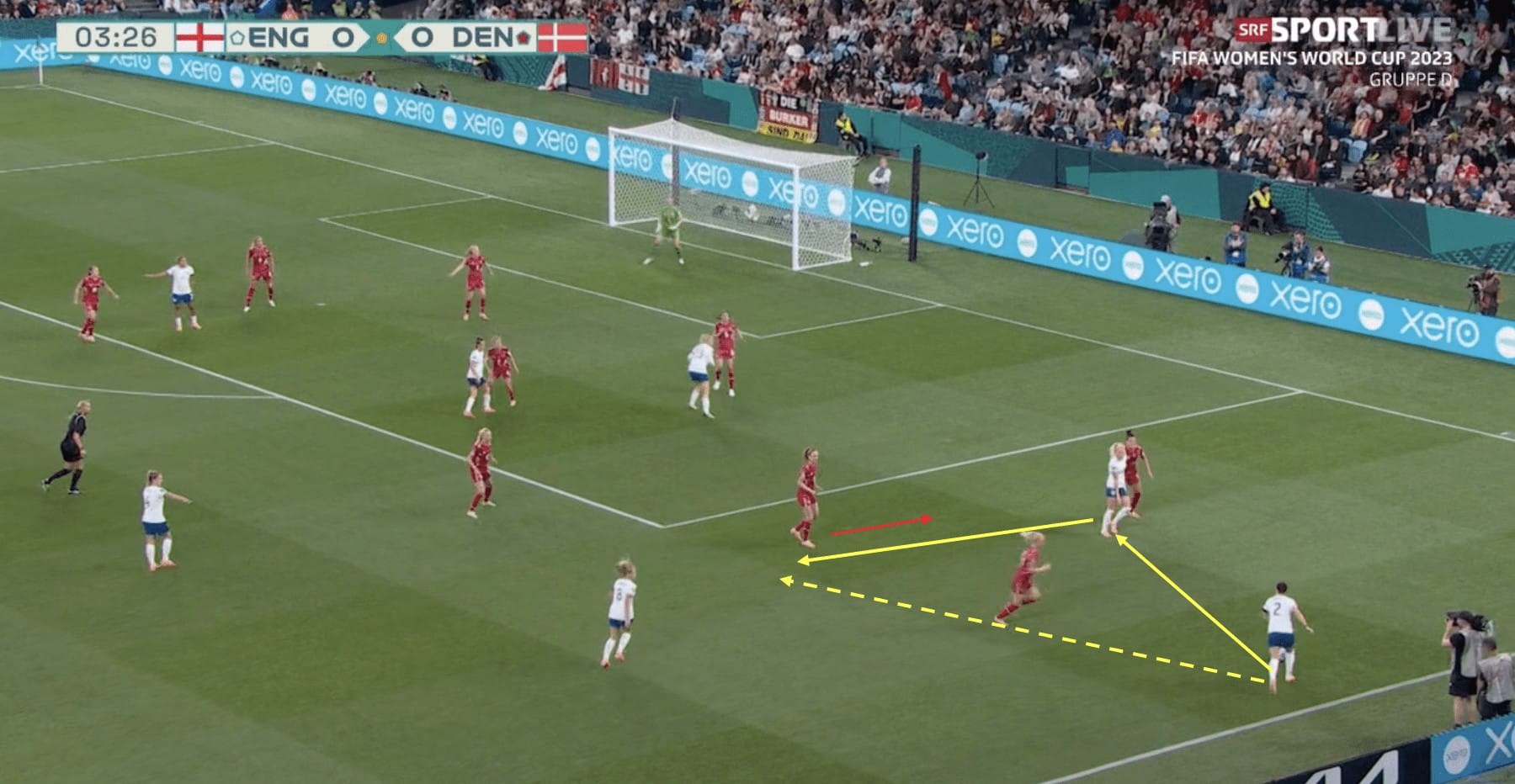
As a consequence of opposition teams becoming aware of Keira Walsh’s passing talents in the middle of the pitch and often aiming to mark her out of the game, Wiegman’s side have increasingly looked to build attacks in wide areas through smart combination play. This was very effective early on, as seen in the image above. Lucy Bronze plays a short pass to Chloe Kelly, which attracts the Danish players towards her. Kelly then plays a pass back into the path of Bronze, who has time and space to execute a cross.

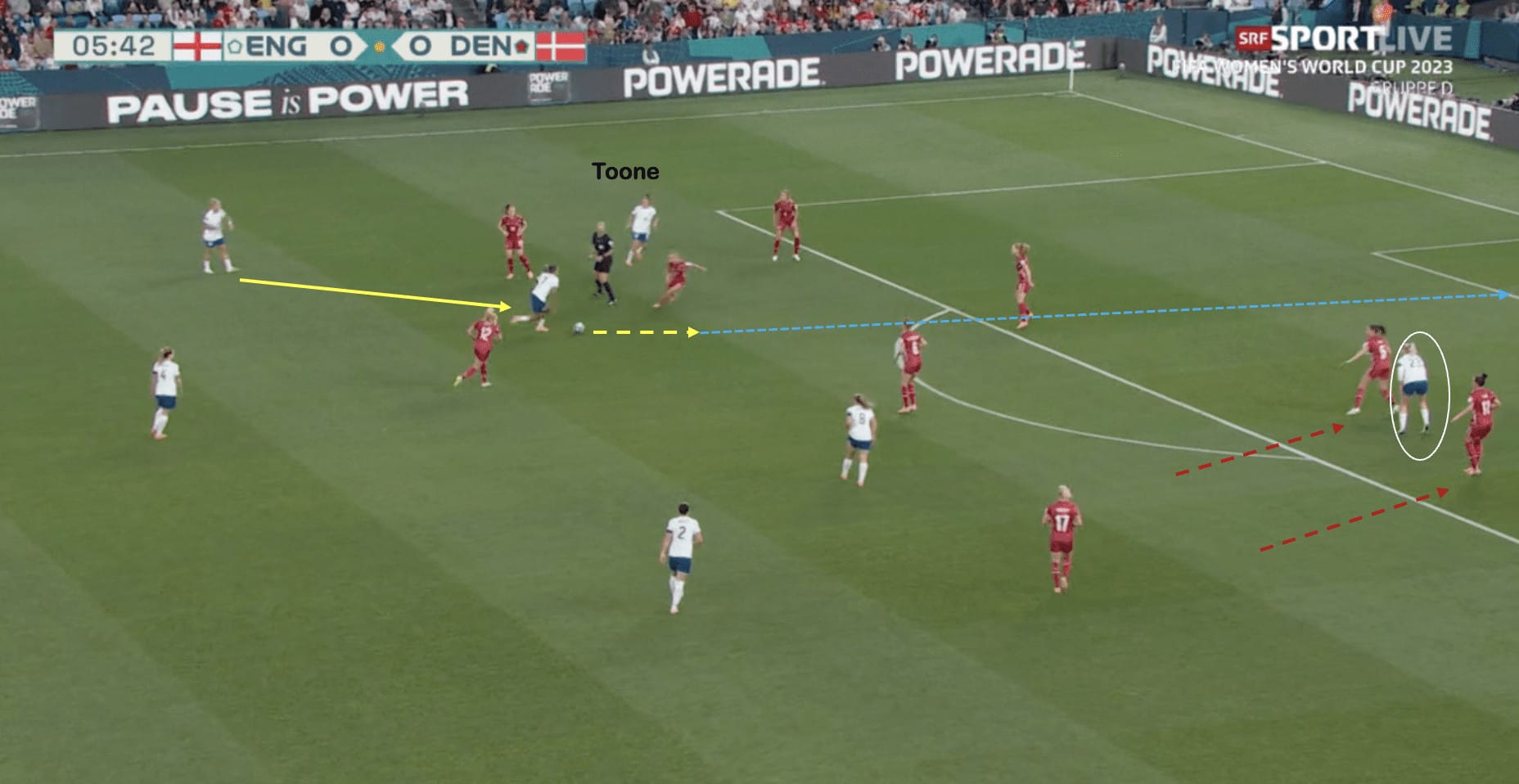
The build-up to this game was heavily focused on the fact that England hadn’t scored a goal from open play in over five hours of football. Lauren James soon put an end to such discussions as her strike from the edge of the area gave the Lionesses an early lead.
The images above depict how the goal played out. Although Alessia Russo has recently struggled to find the back of the net in an England shirt, she played an essential role in this goal. We can see Russo’s positioning between Boye and Veje as Lauren James moves towards Rachel Daly to make herself available to receive a pass. Russo makes an off-the-ball run into the penalty area, which drags both defenders with her, ensuring the back line doesn’t push up to close the space.
Additionally, Ella Toone makes a run into the left half-space, which the Denmark midfielders look to cut off; this, in turn, allows James to carry the ball forward before curling a shot beyond Lene Christensen.
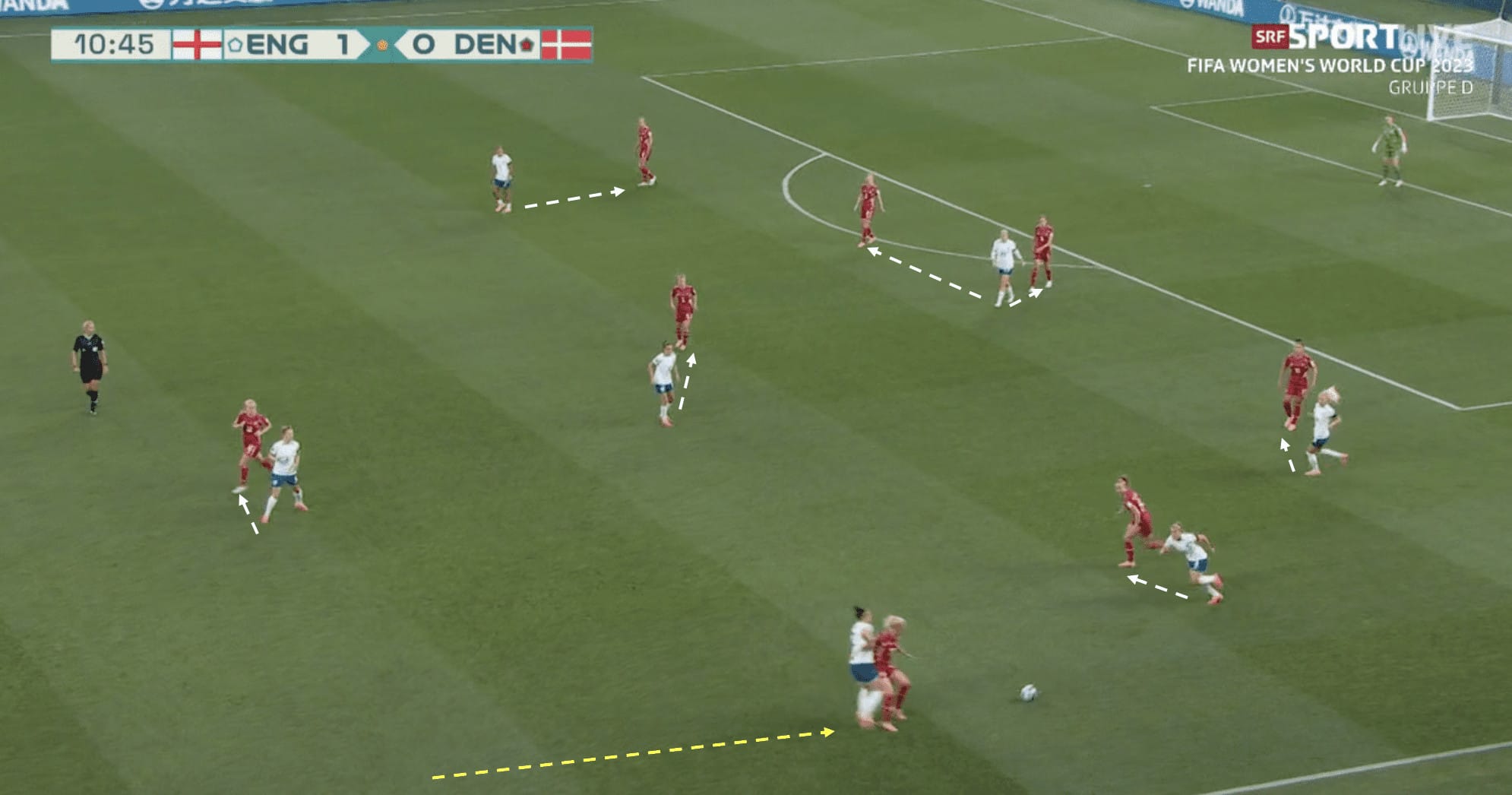
Out of possession, England looked to counterpress aggressively to prevent Denmark from being able to play out of defence. As we can see above, England aimed to shut down the passing lanes and pressed almost player for player. By counterpressing high, the England team were able to keep Denmark pinned in their own half, therefore gaining territorial advantage. This led to more opportunities early on, allowing England to control the game for the first 20 minutes.
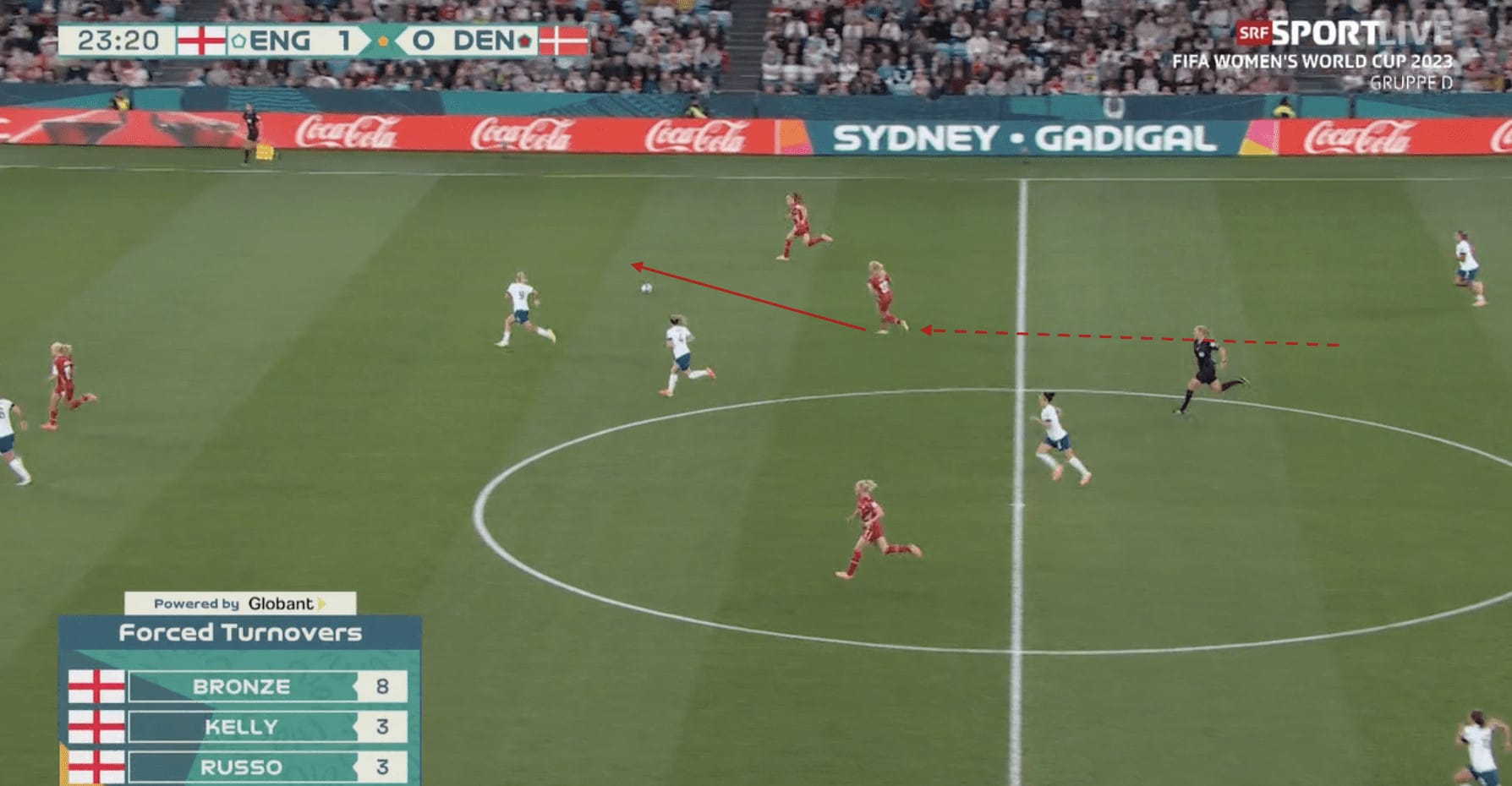
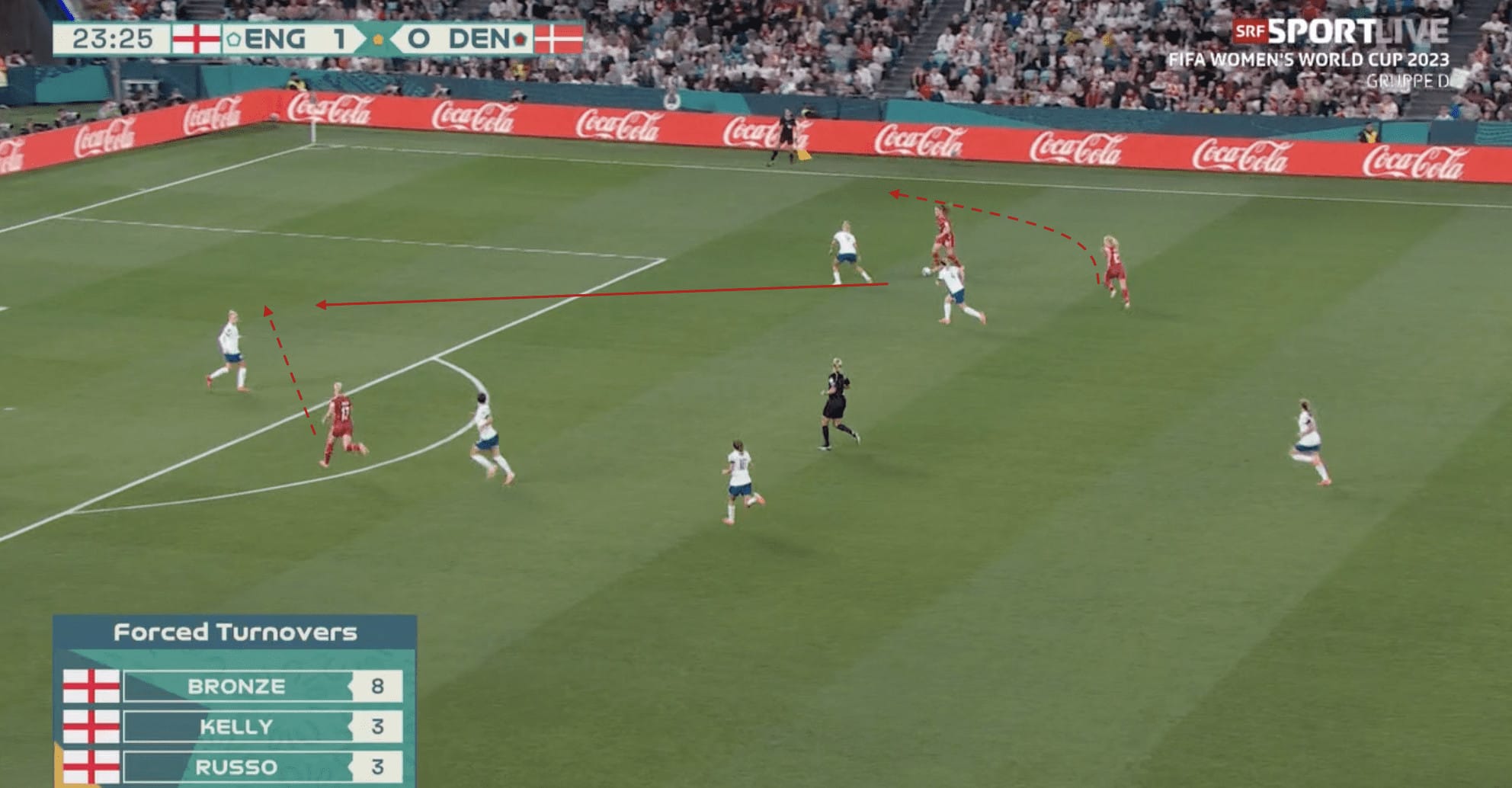
After the 20-minute mark, England appeared to take their foot off the pedal, and some individual errors and questionable decisions that we saw in the Haiti game began seeping into this game. The game became much more transitional, which suited Denmark and allowed them to exploit England’s defensive weaknesses.
In the scenario above, Denmark intercepted an England pass and immediately launched the counterattack.
Thomsen received the ball and was able to carry the Denmark team into the attacking third as England struggled to get back into any sort of defensive shape. She then threaded a simple pass through to Madsen, who made a run across the defender and took the ball on the turn, shielding it from Greenwood.
The Denmark number 17 then executed a fierce shot across goal that was not far away from nestling in the top corner; this should have been a wake-up call for England.
Denmark’s ability to exploit space down England’s right side
Lucy Bronze is integral to the way England play; she so often makes those runs up the right wing into the attacking third. She is often on hand to whip in a cross or engage in a counter-press so England can recover possession. This is why she is one of the best attacking full-backs in the world. However, there is a flip side to this — space. When Bronze goes forward in attack, there is a vast amount of space left down England’s right side. Denmark consistently looked to exploit this space throughout the game.
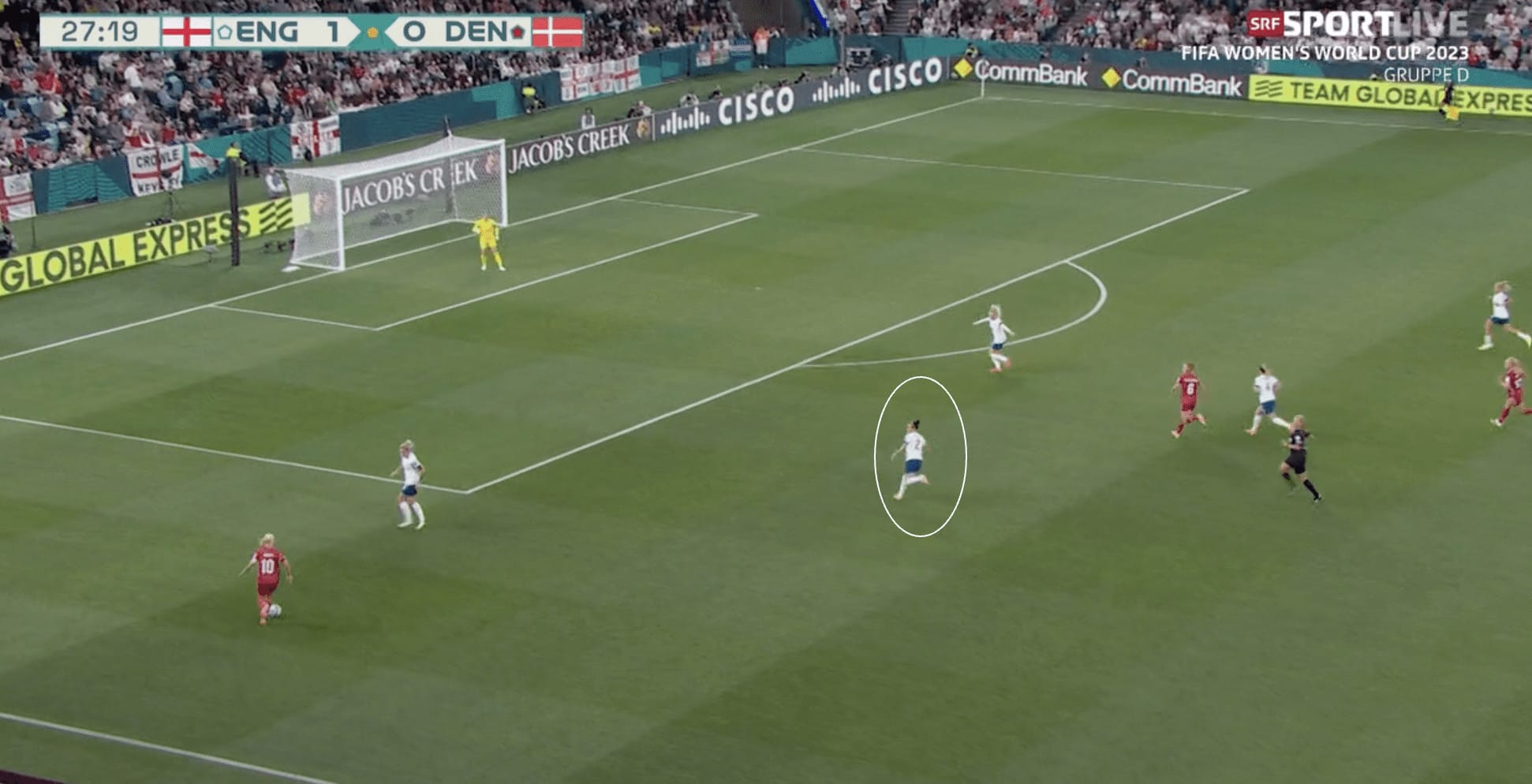
Here, for instance, we can see that Denmark have countered with Harder carrying the ball down England’s right side, utilising the space left by Lucy Bronze. This forced Millie Bright to step out and offer some defensive cover to try and prevent the Denmark forward from getting through 1v1 with the goalkeeper.
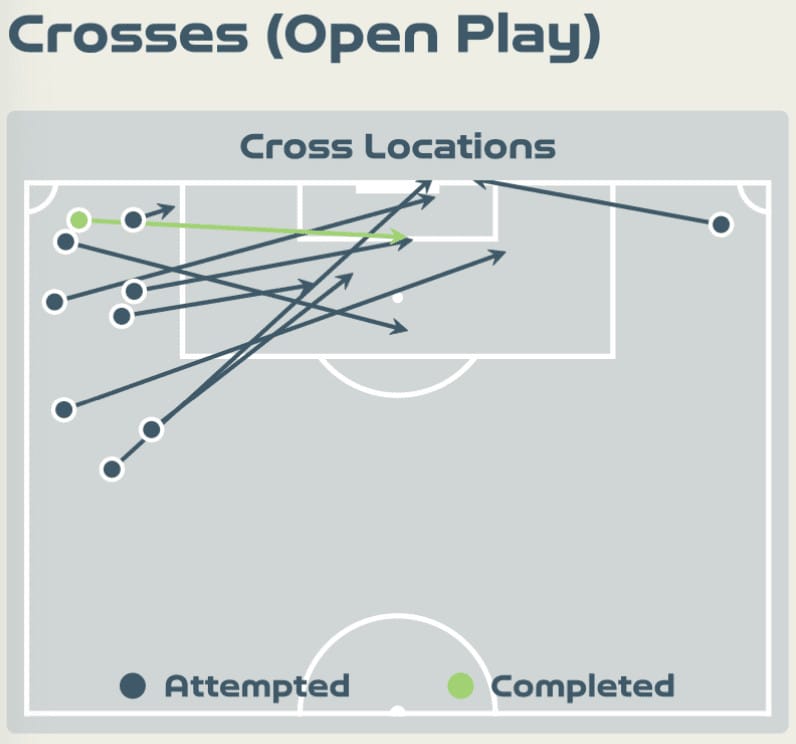
This continued in the second half, and as we can see above, most of Denmark’s crosses occurred from their left wing, with only one from the opposite side. The Danish game plan significantly revolved around utilising the space Bronze leaves behind her when she attacks. This is very much a weak point for England. Likely, other teams will also seek to do this. Especially if the left back pushes higher, this exposes the centre backs and makes it much easier for the opponent to counterattack.
Denmark’s best opportunity came from a cross from their left (England’s right) side. As the Danes worked their way into a crossing position, Amalie Vangsgaard anticipated the cross. She made a darting run across two England defenders to execute a glancing header at goal, as shown below. Thanks to the woodwork, the score remained 1-0 to the Lionesses.
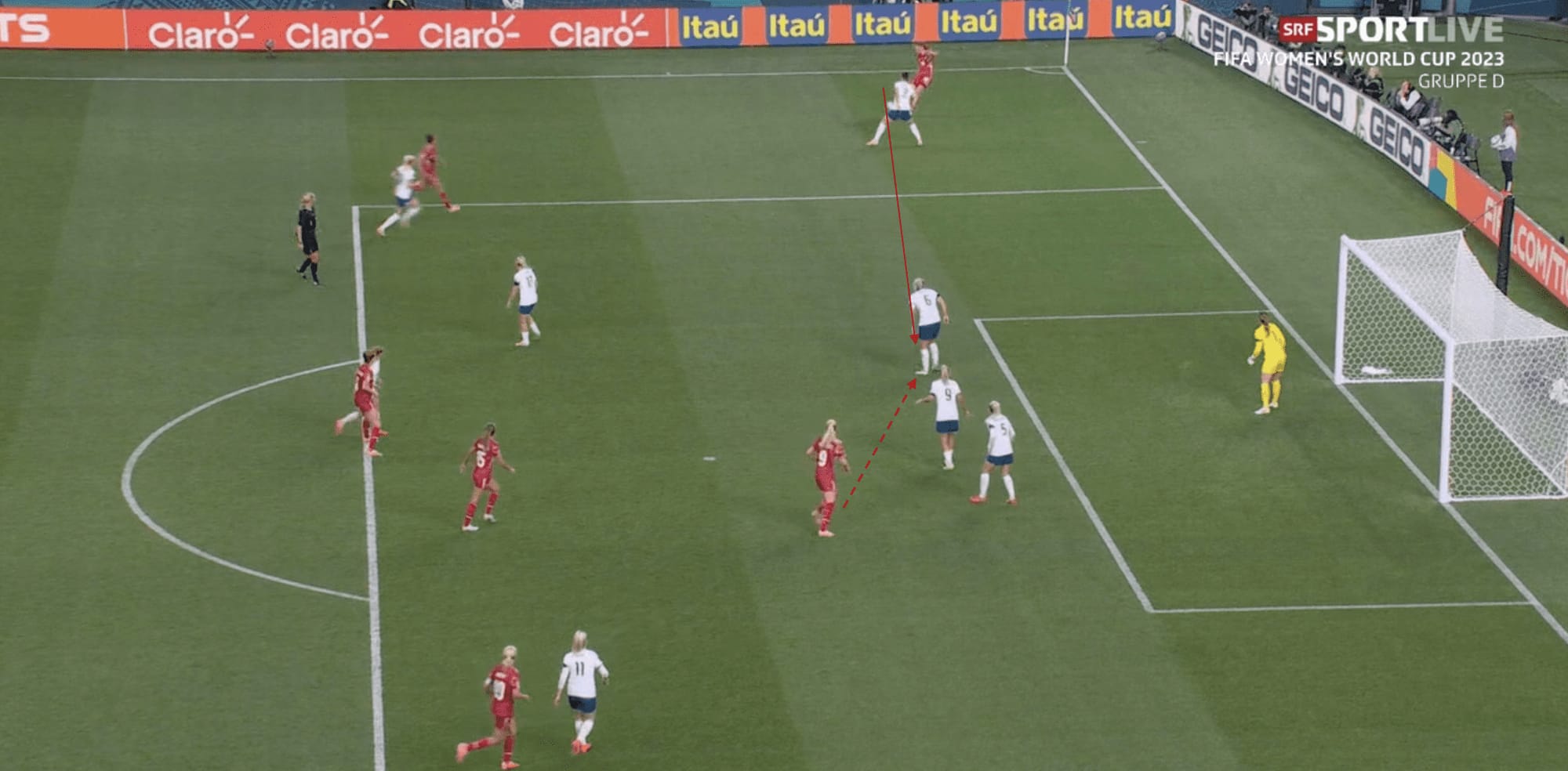
Lack of a secondary playmaker for the Lionesses

We all know about Keira Walsh’s importance to this Lionesses team. As mentioned previously, teams often look to constantly have a player marking her to stifle her playmaking abilities. We can see in the image above that there are two Denmark players surrounding Keira Walsh.
Additionally, Stanway is in a position close to Walsh which means The Danes could intercept a pass to her. This forces Millie Bright to play backwards, allowing Denmark to push higher up, ideally if Stanway were to position herself in the space highlighted. This would have made her available to receive a pass from Bright and allowed England to continue to push forward.
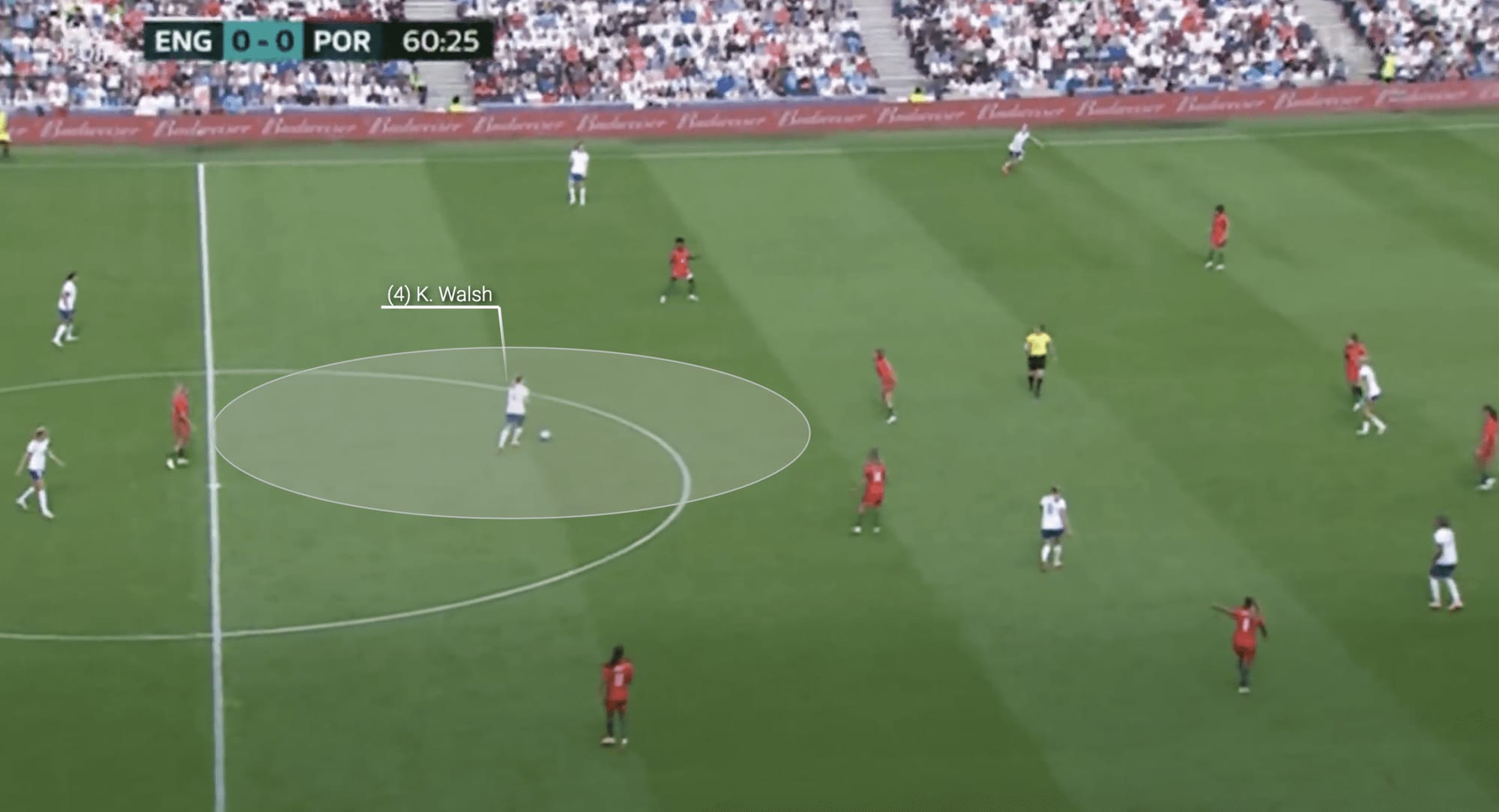
In the pre-World Cup friendly against Portugal, we can see that Walsh had a lot of time and space to play some of her trademark long-range passes to progress the England attack.
The absence of Leah Williamson has also had an impact on England’s build-up play. Previously, Williamson’s ball-carrying abilities have been an important method to bring the ball out of defence when passing lanes to Walsh have been unavailable. Williamson often looks to play a progressive pass into the attacking third, as shown in the data viz below.
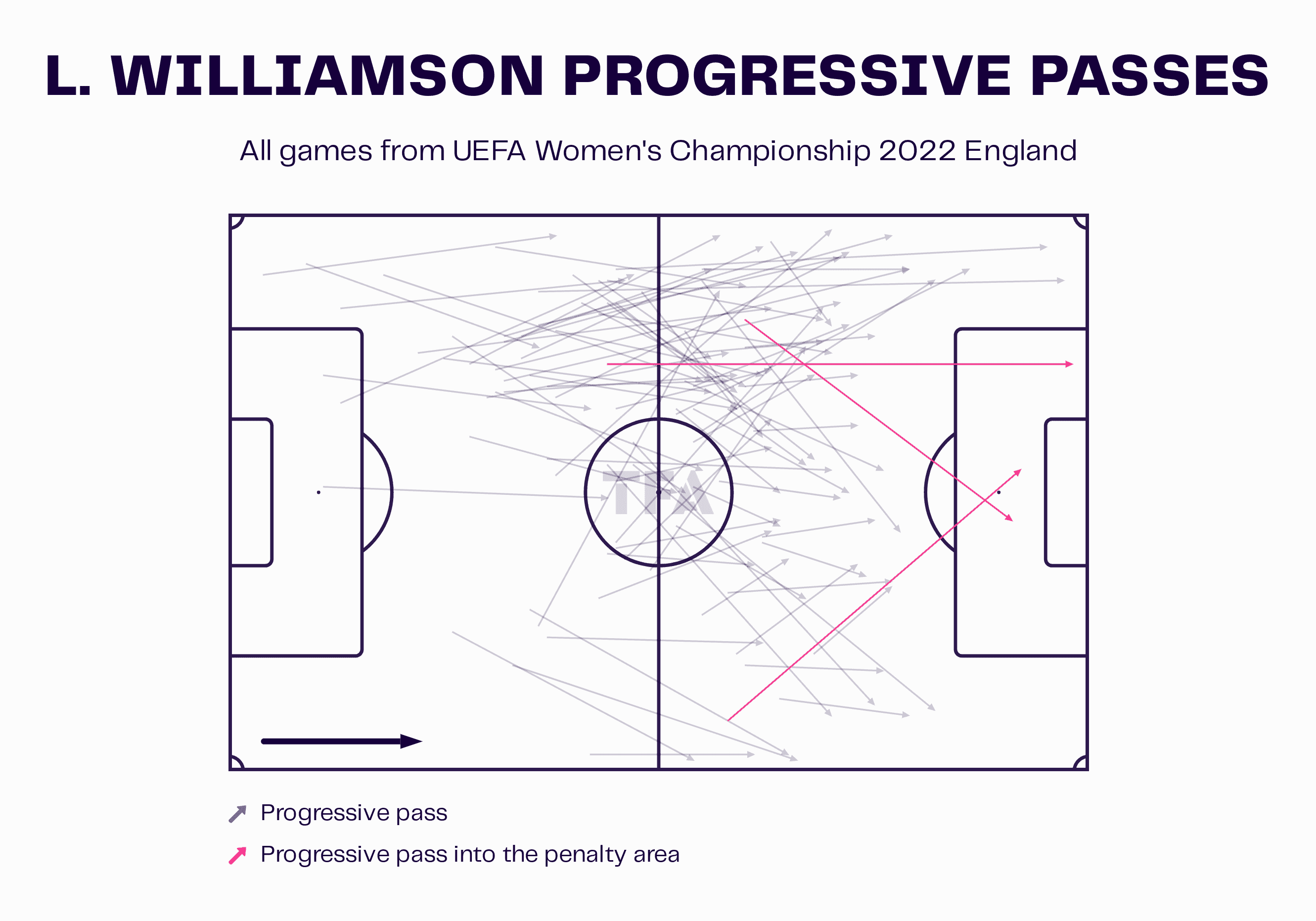
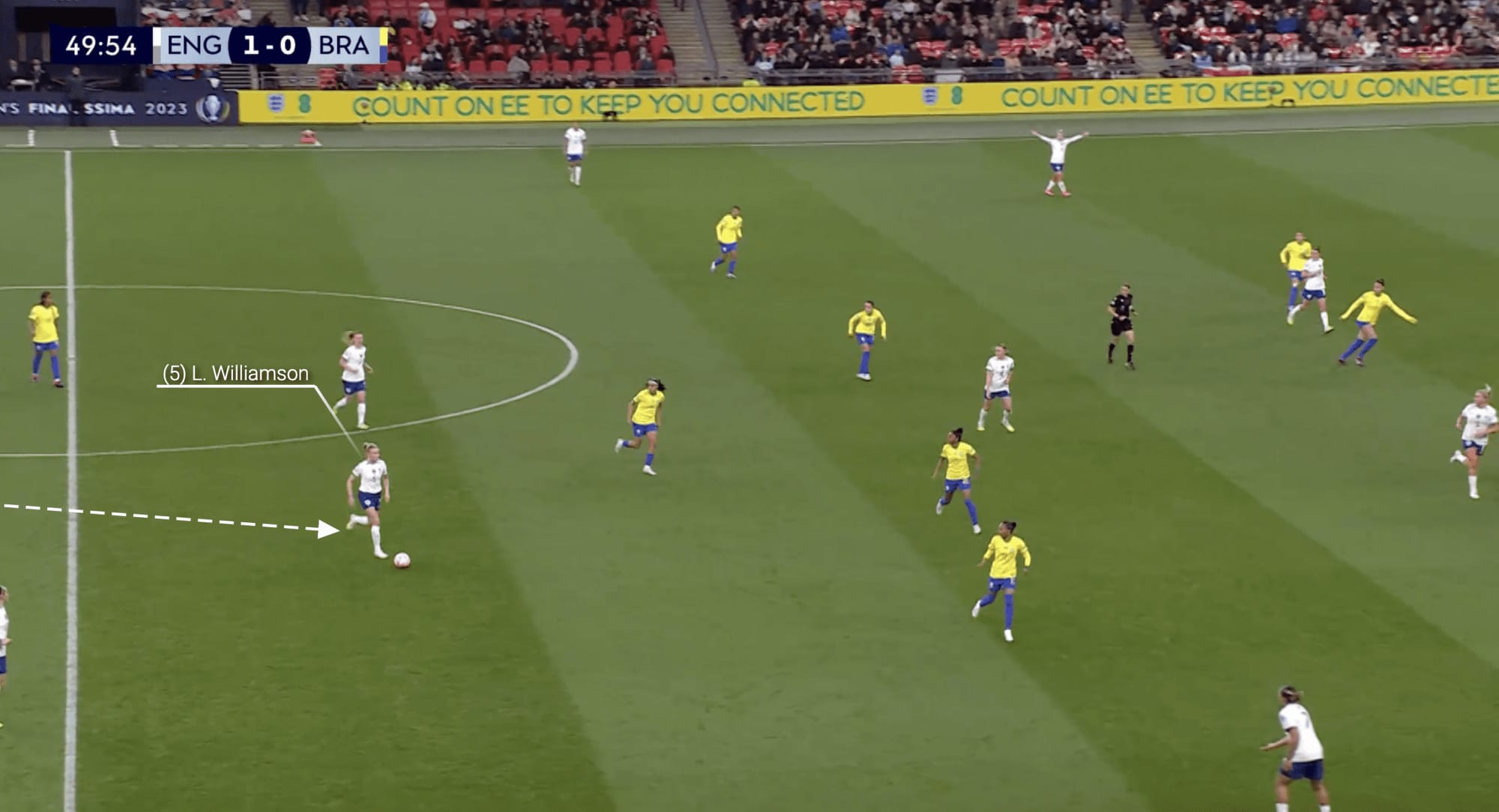
In the Finalissima, Williamson carried the ball out of defence, forcing the Brazil team to drop back. Furthermore, Williamson would look to push up even higher when possible. In the image below, she recovered the second ball and could play a cross into the box.
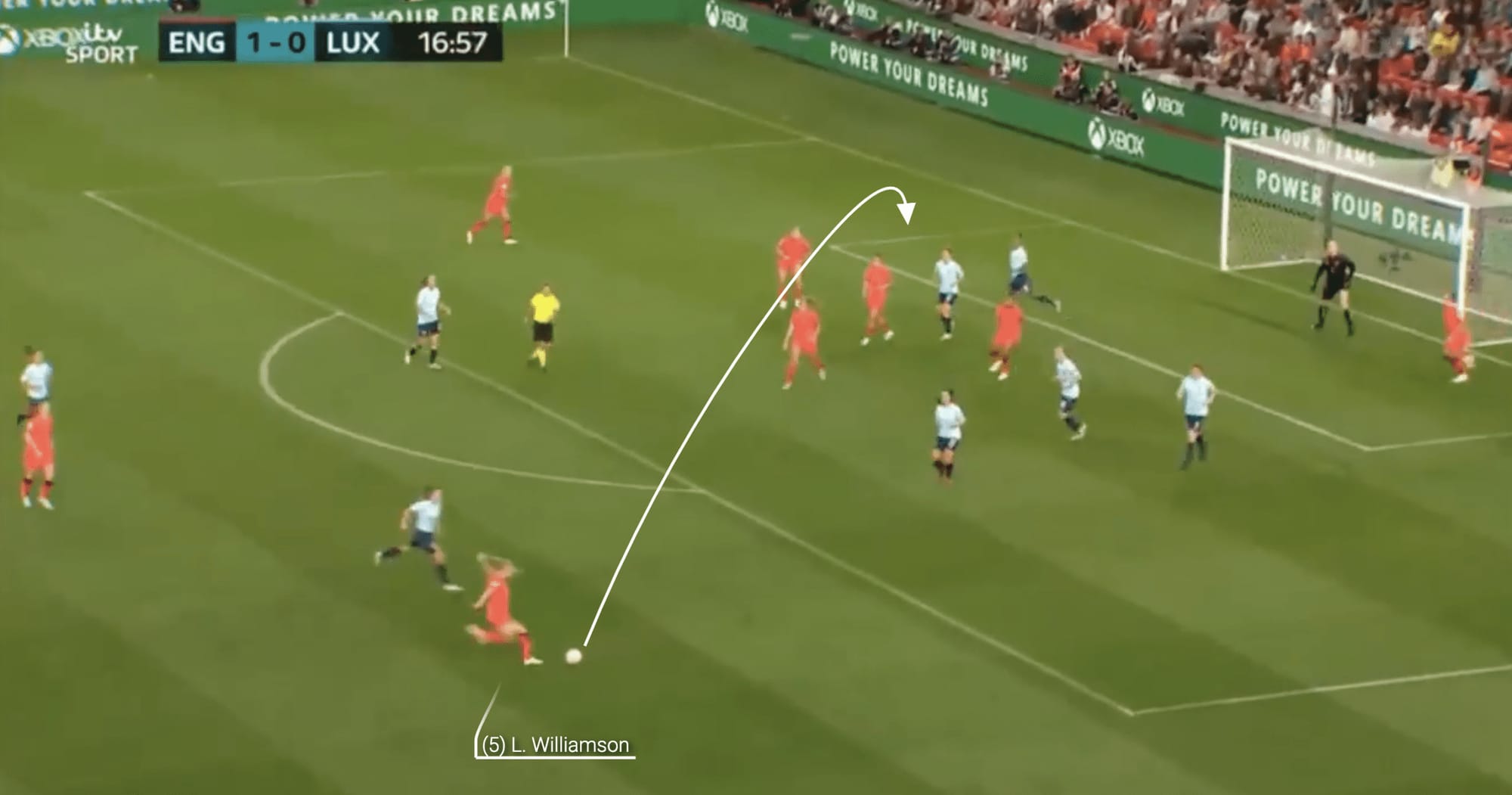
The loss of Williamson was possibly part of Wiegman’s reasoning for moving Alex Greenwood to centre-back for this Denmark game. The Manchester City defender possesses a similar on-the-ball ability to Williamson, which offered England another way of playing out of defence.

Denmark were more than prepared for this, though. As we can see here, Kühl clearly has her eye on Keira Walsh, plus Harder is also looking to press Greenwood to prevent her from finding a pass or carrying the ball out of defence herself.
The 35th-minute injury sustained by Keira Walsh meant she could no longer play a part in proceedings. This saw Georgia Stanway drop deeper to act as the pivot player, whilst Laura Coombs took Stanway’s place as the box-to-box midfielder. This did not change the Danish approach to their defensive strategy, nor did it appear to change England’s approach. Denmark looked to force England to play the ball into the wide areas rather than building up through the central areas.
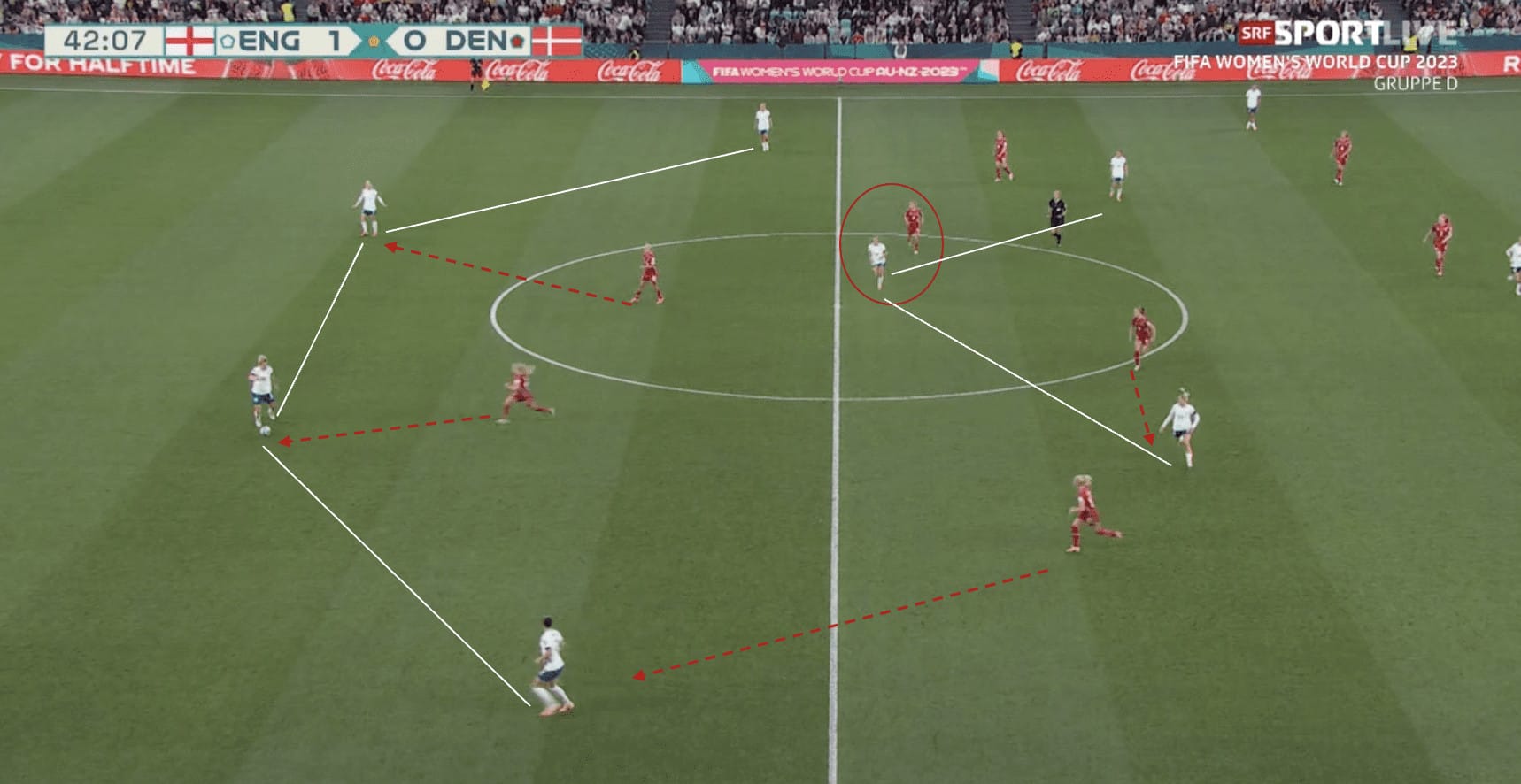
In the image above, England is in their 4-3-3 shape, while Denmark is in their 4-4-2 defensive shape. Stanway, now the pivot player for England, is under the watchful eye of a Danish midfielder. Denmark looked to press the England centre-backs to prevent them from playing in central areas. As the ball reaches Lucy Bronze at right back, Denmark will look to force turnovers. This proved somewhat effective for Denmark as Lucy Bronze turned the ball over more than any other England player.
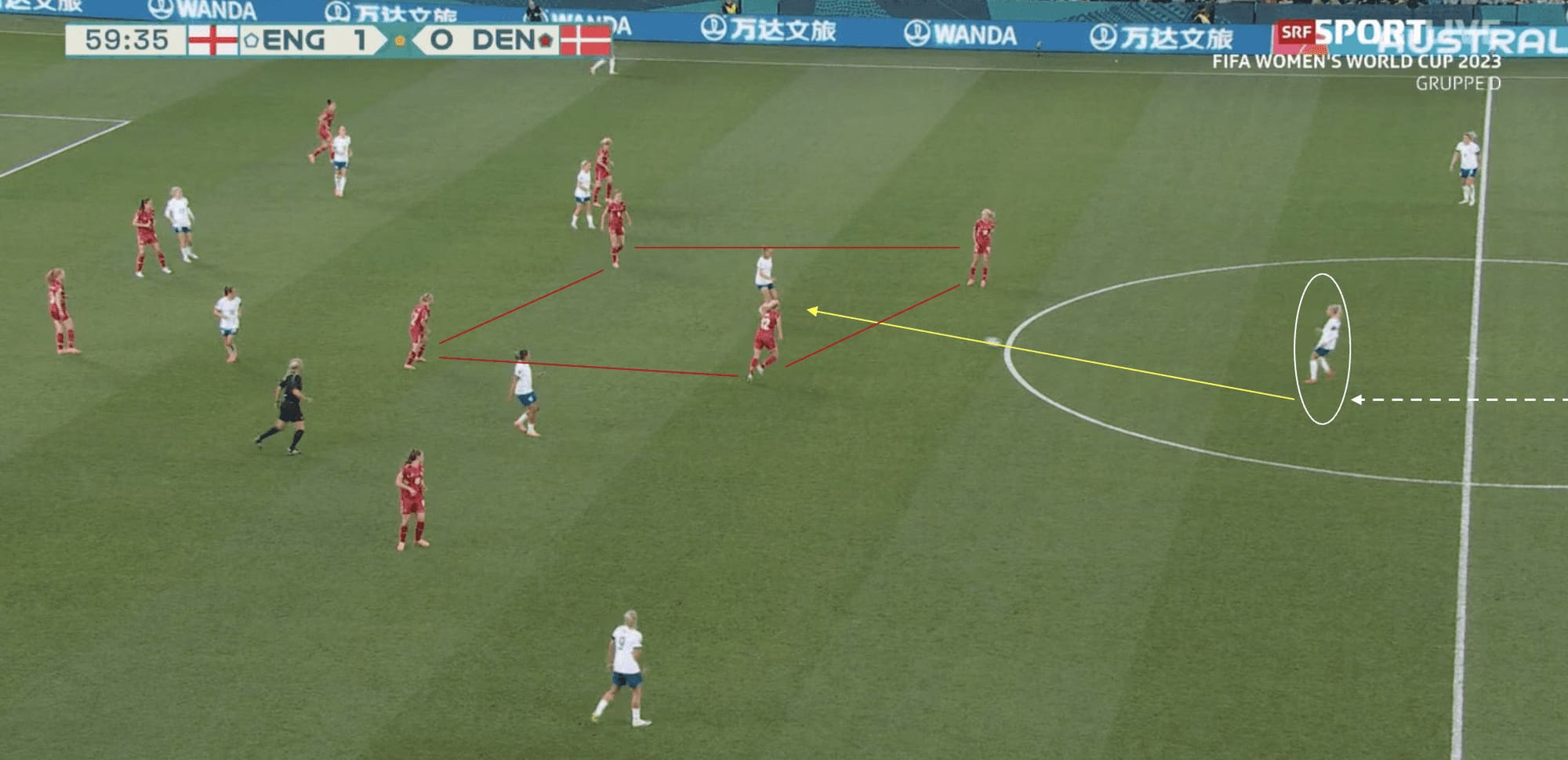
England saw the majority of possession with 59.6%, but most of it was in front of the Denmark defensive structure; we saw very few runs in behind from this England team. On the rare occasion that Greenwood did carry the ball out of defence, Denmark were happy to let her do so.
It appears as though England’s only attacking game plan is to play to the pivot player who acts as the playmaker. The pivot will look to play pass through the lines or spread the play out wide as the attack progresses. We can see in the image above; Greenwood plays the ball into Stanway, who has four Danish players near her. They initiate a press when she receives the ball, and the attack ends.
England are at their best when they are playing sharp passes and moving the ball quickly, dragging opponents out of position by constantly rotating. For the majority of the game against Denmark, it was all too slow and pedestrian. There were very few positional rotations and little movement between the attacking players. This made it easy for Denmark to stifle England and limit their attacking play.
Additionally, Denmark were a constant threat on the counter as their transitional play was excellent. The Danes generated a good amount of opportunities and executed their game plan well. They can consider themselves unlucky not to grab a point.
Conclusion
This game represented an improvement for England compared to how they played against Haiti. The first 20 minutes showed that the Lionesses can still produce that swift and aggressive attacking play we have become accustomed to. However, once individual errors and a lack of ideas began to creep in, England struggled to maintain control over the game and were somewhat fortunate in their victory.
With Keira Walsh ruled out of the final group game against China, it is highly likely Georgia Stanway will fill in at the base of the midfield, whilst any one of Laura Coombs, Jordan Nobbs or Katie Zelem could play alongside Ella Toone.
England will likely qualify for the knockout rounds, but they will have to produce much better performances if they are to live up to expectations.





Comments